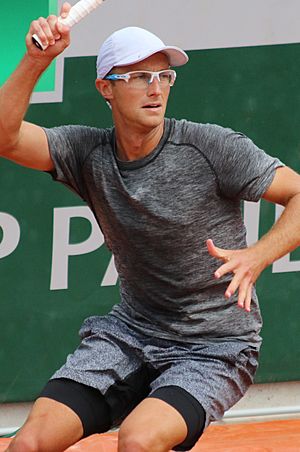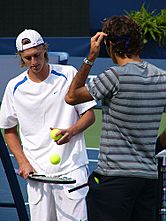Peter Polansky facts for kids

Polansky at the 2018 French Open
|
|
| Country (sports) | |
|---|---|
| Residence | Toronto, Canada Tampa, Florida, United States |
| Born | June 15, 1988 North York, Ontario, Canada |
| Height | 1.83 m (6 ft 0 in) |
| Turned pro | 2007 |
| Plays | Right-handed (two-handed backhand) |
| Prize money | US$1,729,767 |
| Singles | |
| Career record | 19–45 (29.69%) |
| Career titles | 0 |
| Highest ranking | No. 110 (25 June 2018) |
| Grand Slam singles results | |
| Australian Open | 1R (2009, 2017, 2018) |
| French Open | 1R (2009, 2014, 2018) |
| Wimbledon | 1R (2018) |
| US Open | 2R (2010) |
| Doubles | |
| Career record | 3–7 (30%) |
| Career titles | 0 |
| Highest ranking | No. 123 (December 10, 2018) |
| Grand Slam doubles results | |
| Wimbledon | Q1 (2017, 2018) |
| Team competitions | |
| Davis Cup | 1R (2014) |
Peter Polansky (pronounced pə-LAN-skee) is a professional tennis player from Canada. He was born on June 15, 1988. Peter was once Canada's top singles player in the ATP rankings. This was from June 2010 to January 2011. He was also Canada's second-best player for a long time before that.
In 2018, Peter made history in tennis. He became the first player ever to get into all four major Grand Slam tournaments in one year as a "lucky loser". A lucky loser is a player who loses in the final round of qualifying but still gets to play in the main tournament because another player drops out.
Contents
About Peter Polansky
Peter Polansky was born in North York, Ontario, Canada. His family is originally from the Czech Republic.
When he was 18, Peter had a scary accident. He was in Mexico for a Davis Cup tennis event. One night, he was sleepwalking and fell from a third-story room. He was seriously hurt. Peter later said he thought he saw a dark figure with a knife and tried to escape. Amazingly, he recovered quickly and was back playing tennis just four months later.
Peter has been coached by Dean Coburn for much of his career.
Peter's Tennis Journey
Early Career (2004–2006)
Peter started playing in professional "Futures" tennis events in 2004. He won one match and lost four. In 2005, he played in a bigger event called a "Challenger" but lost early. He slowly improved his ranking.
In 2006, Peter's ranking got into the top 1000 players. He played in his first big ATP tournament, the 2006 Rogers Cup, but lost in the first round. Later that year, he had a great run at the US Open boys' singles tournament. He beat some top young players and reached the final, but he didn't win the championship. He finished 2006 ranked 821st in the world.
Rising Through the Ranks (2007–2008)
Peter started 2007 very well, winning three "Futures" tournaments in Central America. His ranking jumped to 580. He also played in his first Davis Cup match for Canada. He continued to play well in "Futures" events and then moved on to "Challenger" tournaments. By the end of 2007, he was ranked 343rd.
In 2008, Peter kept improving. He won another "Futures" tournament and helped Canada win a Davis Cup match against Mexico. He started reaching the quarterfinals and semifinals of "Challenger" events. He even played in a main ATP tournament in Morocco. Peter also tried to qualify for Wimbledon and the US Open for the first time. He finished the year strong, reaching the semifinals of a "Challenger" in Rimouski.
Battling Injuries and Breakthroughs (2009–2010)
Peter started 2009 by playing in the Australian Open, his first major Grand Slam event. He qualified for the main draw but lost in a tough five-set match. He then had to take a month off due to a shoulder injury.
After recovering, Peter qualified for the French Open main draw. He played another long five-set match but lost. He continued to play in "Challenger" events and reached the semifinals of the Granby Challenger. At the Rogers Cup in Montreal, he won a match before losing to the famous player Novak Djokovic. Peter's ranking reached a new high of 200.

He then qualified for the US Open. In his first main draw match, he came back from two sets down but still lost in five sets. By October 2009, his ranking was a career-high of 170.
In 2010, Peter continued to play in qualifying rounds for major tournaments. He had some good wins in "Challenger" events. In June 2010, he became Canada's number one singles player for a few months. At the 2010 Rogers Cup, he had a big win against Jürgen Melzer before losing in the second round.
Later in 2010, Peter qualified for the US Open again. He won his first-round match against a seeded player, Juan Mónaco, which was a big achievement. He was the first Canadian to reach the second round of the US Open since 2000. He then lost to James Blake. After the US Open, Peter helped Canada win a Davis Cup match against the Dominican Republic.
Later Career and "Lucky Loser" Slam (2017–2018)
In 2017, Peter started the year well by reaching the quarterfinals of a "Challenger" event in Australia. He qualified for the Australian Open but lost in the final qualifying round. However, he got into the main tournament as a "lucky loser" because another player pulled out. He had to retire from his first-round match due to illness.
Peter had a tough few months after that. But in July, he played very well in Canadian "Challenger" events. He reached the finals of three tournaments in a row, which helped his ranking reach a new high of 115. He then played at the Rogers Cup in Montreal, beating Vasek Pospisil before losing to the world number three, Roger Federer.
The year 2018 was very special for Peter. He qualified for the Australian Open again. For the second year in a row, he got into the main draw as a "lucky loser." He lost a close match in the first round.
In March, Peter qualified for a big tournament in Indian Wells. He won an incredibly long and exciting first-round match that lasted over three hours. He saved two match points and won on his eighth match point! He then lost in the second round.
Peter also qualified for the French Open and Wimbledon in 2018. In both tournaments, he lost in the final qualifying round but again got into the main draw as a "lucky loser." This meant he had been a lucky loser in three Grand Slams in a row!
In August, Peter played at the 2018 Rogers Cup again. He reached the second round before losing to Novak Djokovic. Then, at the US Open, he qualified for the main draw. For the fourth time in 2018, he became a "lucky loser" for a Grand Slam! This amazing achievement was called the "lucky loser" slam. He lost to Alexander Zverev in the first round.
Peter had a great year in 2018, winning 46 matches. He played in more ATP events than ever before. He also won a "Challenger" tournament in Granby, Canada. He reached his highest singles ranking ever, number 110, in June 2018. He finished the year ranked 121st, his best year-end ranking. He also reached his best doubles ranking, 125th.
Grand Slam Results
Peter has played in the main draw of all four Grand Slam tournaments. He has won one match at the US Open.
Singles Grand Slam Results
| Tournament | 2009 | 2010 | 2017 | 2018 | Win–loss |
|---|---|---|---|---|---|
| Australian Open | 1R | Q1 | 1R | 1R | 0–3 |
| French Open | 1R | Q1 | Q2 | 1R | 0–3 |
| Wimbledon | A | Q1 | Q3 | 1R | 0–1 |
| US Open | 1R | 2R | Q3 | 1R | 1–3 |
| Total Win–loss | 0–3 | 1–1 | 0–1 | 0–4 | 1–10 |
Major Tournament Wins
Peter has won several "Challenger" and "Futures" tournaments in both singles and doubles. These are important tournaments below the main ATP Tour level.
Singles Titles (19)
- 2007: El Salvador F1, Guatemala F1, Costa Rica F1, USA F6
- 2008: Guatemala F1
- 2011: Canada F7, Venezuela F8, USA F26
- 2012: USA F5, Canada F7
- 2013: Canada F7, Canada F8, Tiburon Challenger
- 2016: USA F16, Canada F3, Canada F4, Gatineau Challenger
- 2018: Granby Challenger
- 2019: Columbus Challenger
Doubles Titles (22)
- 2008: Granby Challenger (with Philip Bester)
- 2011: Burnie Challenger (with Philip Bester), Canada F7 (with Milan Pokrajac)
- 2012: Canada F7 (with Carsten Ball)
- 2013: Granby Challenger (with Érik Chvojka), Lexington Challenger (with Frank Dancevic)
- 2014: Manta Challenger (with Chase Buchanan), Lexington Challenger (with Adil Shamasdin), Napa Challenger (with Adil Shamasdin)
- 2015: Granby Challenger (with Philip Bester)
- 2016: Cuernavaca Challenger (with Philip Bester), Canada F3 (with Philip Bester), Canada F5 (with Philip Bester), Cary Challenger (with Philip Bester), Knoxville Challenger (with Adil Shamasdin)
- 2017: Savannah Challenger (with Neal Skupski)
- 2018: Bordeaux Challenger (with Bradley Klahn), Columbus Challenger (with Tommy Paul)
- 2019: Winnipeg Challenger (with Darian King), Fairfield Challenger (with Darian King)
- 2021: Orlando Challenger (with Christian Harrison), Columbus Challenger (with Stefan Kozlov)
Junior Grand Slam Final
Peter reached one major final as a junior player.
Singles: 1 (1 runner-up)
| Result | Year | Tournament | Surface | Opponent | Score |
|---|---|---|---|---|---|
| Loss | 2006 | US Open | Hard | 6–7(4–7), 3–6 |
See also
 In Spanish: Peter Polansky para niños
In Spanish: Peter Polansky para niños

